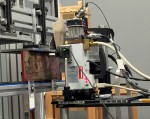A new blend of imaging technologies has helped archaeologists identify the chemical makeup of an excavated painting, revealing elements of everyday life in second century Egypt.
Researchers from UCLA and the National Gallery of Art in Washington, D.C., published a study earlier this month that examined a more-than-1,800-year-old portrait of a woman. Archaeologists believe the painting, called a mummy portrait because it was found covering the face of a mummified body, depicts a real person who lived in Greek and Roman Egypt.
Ioanna Kakoulli, a professor of materials science and engineering at UCLA who co-authored the study, said researchers detected the wavelengths of light reflected or emitted from the painting’s surface to deduce what chemicals were distributed throughout the portrait. They found that the same pigments that colored the woman’s clothing and jewelry in the painting were used to dye real clothing and to stain stones. Kakoulli said this information could help historians understand the social practices in Egypt at that time.
Art conservators usually analyze chemicals in a painting by removing tiny samples from already damaged parts of a painting, said John Delaney, a senior imaging scientist at the National Gallery of Art who co-authored the study. To analyze entire artworks without damaging them, researchers have been adapting imaging techniques used on airplanes and satellites to scan the Earth’s environment.
“We’ve been developing (the technology) to the capability of mapping and identifying artists’ materials in Old Masters’ paintings,” Delaney said. “Working at a museum, those are very important tools.”
The researchers in the study captured several types of images of the excavated painting, Kakoulli said. They used two techniques called hyperspectral diffuse reflectance and luminescence to shine ultraviolet, visible and infrared light onto the painting and measure the amount of light reflected or emitted. The resulting patterns of wavelengths reflected or emitted from the painting are unique to particular molecular structures and indicate their presence in the artwork.
With a third method called X-ray fluorescence, the researchers directed X-rays onto the painting and measured light emissions that signal the presence of certain elements, such as iron and lead. The combined information from the imaging methods helped the researchers narrow down the materials that might be present, Kakoulli said.
Roxanne Radpour, a graduate student in materials science and engineering who co-authored the study, said the researchers discovered that the woman’s tunic in the portrait was painted with a purple-red pigment called madder lake.
To prepare madder lake, Egyptians would extract madder from the roots of a flowering plant and mix it with metal salts, Radpour said. According to alchemy manuals, they used the same procedure to dye textiles for their clothing, she added.
“They brought this into the portrait to mimic what was happening in real life,” she said.
The artist could have instead produced the same color using red mineral pigments, such as the iron oxides used in the portrait to paint the woman’s lips, but chose to use madder lake, Radpour added. She said studies of other mummy portraits have shown that madder lake appears in the garments of those paintings as well.
“There’s a trend; there’s a choice amongst all these artists, of choosing to decorate certain things based on contemporary practices,” Radpour said. “There’s an intention behind it that’s connected to society.”
Kakoulli said there seems to be connections between painting and other chemical industries, such as metallurgy and medicine, in Greek and Roman Egypt.
Archaeologists have found containers filled with pigments that have the same chemical compositions as powders used for cosmetics or medicine, Kakoulli said.
The artist also used a green pigment produced from copper acetate to paint the woman’s necklace, she said. Alchemists used the same pigment to stain gemstones to make them look like emeralds.
“Everything, even the colors of the processes of alchemy, corresponds to some of the colors that you have in painting,” Kakoulli said. “It was philosophy driving experimentation in many ways.”
Kakoulli said the woman’s hairstyle, clothing and jewelry suggest she was of a higher social status.
The researchers also found that the binder, the ingredient artists use to make paint adhere to a surface, was melted wax, which requires a more elaborate technique to paint with than egg tempera, another binder typically used in mummy portraits.
“(There’s) more difficulty in terms of execution to melt the wax, mix the pigments in the wax, have someone perhaps to warm the wax with the pigment while you paint,” Kakoulli said. “That’s another thing that shows more wealth.”
Radpour said the portrait is painted with rich textures, suggesting the artist used three different types of tools – a fine painter’s brush, a metal spoon and an engraver. Contemporary artists used the same tools to paint insides of sarcophagi and marble statues.
“We see this imitation of what was happening in society in the practices, the tools, the garments, that was being realized in the portraits,” Radpour said.
“Now we can take it to other sites, other time periods and other civilizations,” she said.
